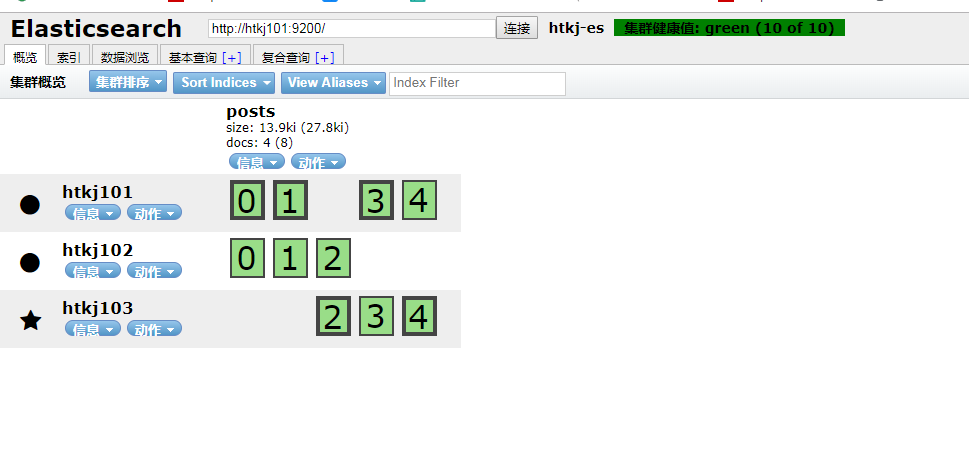1. Download the installation package
wget https://artifacts.elastic.co/downloads/elasticsearch/elasticsearch-6.8.3.tar.gz
After downloading, decompress.
The address I decompressed is: / usr / local / elastic search 6.8.3
2. Creating Users
- es cannot run as root, so you need to create users
adduser elastic #Create elastic users
- Create esdata in the es installation directory
cd /usr/local/elasticsearch6.8.3 mkdir -p esdata/data mkdir -p esdata/log
- Grant elastic User Rights
chown -R elastic elasticsearch6.8.3
3. Configuring es nodes
- Modify configuration files
vi /usr/local/elasticsearch6.8.3/config/elasticsearch.yml
- The specific configuration is as follows
# ======================== Elasticsearch Configuration ========================= # # NOTE: Elasticsearch comes with reasonable defaults for most settings. # Before you set out to tweak and tune the configuration, make sure you # understand what are you trying to accomplish and the consequences. # # The primary way of configuring a node is via this file. This template lists # the most important settings you may want to configure for a production cluster. # # Please consult the documentation for further information on configuration options: # https://www.elastic.co/guide/en/elasticsearch/reference/index.html # # ---------------------------------- Cluster ----------------------------------- # # Use a descriptive name for your cluster: # cluster.name: htkj-es #The name of the cluster # # ------------------------------------ Node ------------------------------------ # # Use a descriptive name for the node: # node.name: htkj101 #Name of node # # Add custom attributes to the node: # #node.attr.rack: r1 # # ----------------------------------- Paths ------------------------------------ # # Path to directory where to store the data (separate multiple locations by comma): # path.data: /usr/local/elasticsearch6.8.3/esdata/data #data Path # # Path to log files: # path.logs: /usr/local/elasticsearch6.8.3/esdata/log #log Path # # ----------------------------------- Memory ----------------------------------- # # Lock the memory on startup: # bootstrap.memory_lock: true #ES performs poorly in memory switching. Setting this prevents memory switching # # Make sure that the heap size is set to about half the memory available # on the system and that the owner of the process is allowed to use this # limit. # # Elasticsearch performs poorly when the system is swapping the memory. # # ---------------------------------- Network ----------------------------------- # # Set the bind address to a specific IP (IPv4 or IPv6): # network.host: htkj101 #ip address of node # # Set a custom port for HTTP: # http.port: 9200 #Port number http.cors.enabled: true #head plug-in discovery node http.cors.allow-origin: "*" #head plug-in discovery node # # For more information, consult the network module documentation. # # --------------------------------- Discovery ---------------------------------- # # Pass an initial list of hosts to perform discovery when new node is started: # The default list of hosts is ["127.0.0.1", "[::1]"] # discovery.zen.ping.unicast.hosts: ["htkj102", "htkj103"]#The other nodes of the cluster, ip, have only one node to write native ip # # Prevent the "split brain" by configuring the majority of nodes (total number of master-eligible nodes / 2 + 1): # discovery.zen.minimum_master_nodes: 2 #To prevent brain fissure, the number of nodes allocated is the number of clusters / 2 + 1. I have three nodes allocated, so it is 3/2 + 1 = 2. # # For more information, consult the zen discovery module documentation. # # ---------------------------------- Gateway ----------------------------------- # # Block initial recovery after a full cluster restart until N nodes are started: # gateway.recover_after_nodes: 3 #Initial recovery is prevented after the cluster is fully restarted until three nodes are started # # For more information, consult the gateway module documentation. # # ---------------------------------- Various ----------------------------------- # # Require explicit names when deleting indices: # action.destructive_requires_name: true #When deleting an index, you need to have a clear name
4. Configuring System Parameters
- Modify/etc/security/limits.conf
vi /etc/security/limits.conf #Modify the following items and add those that do not. * soft nofile 65536 * hard nofile 131072 * soft nproc 2048 * hard nproc 4096
-
Modify / etc/sysctl.conf, add the following line, and restart the machine
vm.max_map_count=262144
5. boot
- After restarting the machine, start the nodes of es
su elastic #es startup does not use root by default cd /usr/local/elasticsearch6.8.3/bin ./elasticsearch -d
- The browser accesses the ip:port and the following information indicates that the installation was successful
{ "name" : "htkj101", "cluster_name" : "htkj-es", "cluster_uuid" : "_na_", "version" : { "number" : "6.8.3", "build_flavor" : "default", "build_type" : "tar", "build_hash" : "0c48c0e", "build_date" : "2019-08-29T19:05:24.312154Z", "build_snapshot" : false, "lucene_version" : "7.7.0", "minimum_wire_compatibility_version" : "5.6.0", "minimum_index_compatibility_version" : "5.0.0" }, "tagline" : "You Know, for Search" }
6. Deploy the head plug-in
- Download the head plug-in
#The head plug-in only needs to be deployed on one node to select the htkj101 node here wget https://github.com/mobz/elasticsearch-head/archive/master.zip unzip elasticsearch-head-master.zip
- Installation environment
cd /usr/local/elasticsearch-head-master #The following operations are performed in the elastic search-head-master directory su root #Under the root role curl -sL https://rpm.nodesource.com/setup_8.x | bash - sudo yum install gcc-c++ make curl -sL https://dl.yarnpkg.com/rpm/yarn.repo | sudo tee /etc/yum.repos.d/yarn.repo yum -y install yarn nodejs git npm install -g grunt-cli
- Install grunt
npm install grunt --save-dev npm install
- Modify Gruntfile.js
vi /usr/local/elasticsearch-head-master/Gruntfile.js #Amend the following paragraph: connect: { server: { options: { port: 9100, hostname: '*', #Add the line hostname base: '.', keepalive: true } } }
- Start the head service
#Start the service under the elastic search-head-master directory cd /usr/local/elasticsearch-head-master grunt server &
- The following information appears
Running "connect:server" (connect) task Waiting forever... Started connect web server on http://localhost:9100
- Open browser, access http://ip:9100 (ip is the node IP that installs the head plug-in)

- Successful installation